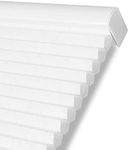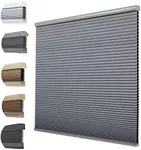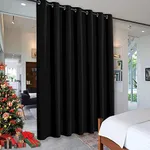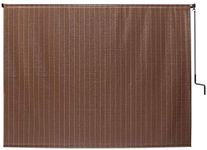Buying Guide for the Best Heat Blocking Blinds
When choosing heat-blocking blinds, your main goal is to reduce the amount of heat entering your space while still maintaining comfort, privacy, and style. The right blinds can help keep your home cooler in the summer, lower your energy bills, and protect your furniture from sun damage. To make the best choice, it's important to understand the key features that affect how well blinds block heat and how they fit into your daily life.MaterialThe material of the blinds plays a big role in how well they block heat. Common materials include fabric, wood, faux wood, aluminum, and specialized thermal or reflective coatings. Heavier and denser materials, as well as those with reflective surfaces, tend to block more heat. If you want maximum heat reduction, look for blinds specifically labeled as thermal or heat-reflective. For moderate needs, standard wood or faux wood can offer a balance between insulation and appearance. Consider your climate and how much direct sunlight your windows receive to decide which material is best for you.
OpacityOpacity refers to how much light the blinds let through. Blinds can range from sheer (letting in a lot of light) to blackout (blocking almost all light). Higher opacity blinds, like blackout or room-darkening options, are better at blocking heat because they prevent sunlight from entering. If you want to keep your room as cool as possible, choose blinds with high opacity. If you prefer some natural light, look for blinds that offer a balance between light filtering and heat blocking.
Slat Size and DesignThe size and design of the slats affect both the look and the performance of the blinds. Wider slats can provide better coverage and block more heat when closed, while narrower slats may allow more light and heat to pass through. Some designs, like honeycomb or cellular blinds, trap air in pockets, providing extra insulation. If heat blocking is your top priority, consider blinds with larger slats or cellular designs. If you want more control over light and privacy, adjustable slats might be a better fit.
Fit and InstallationHow well the blinds fit your window can impact their effectiveness at blocking heat. Blinds that fit snugly inside the window frame with minimal gaps will prevent more heat from sneaking in around the edges. If you have unusually shaped or sized windows, consider custom-fit options. For standard windows, measure carefully and choose blinds that cover the entire window area for the best results.
Ease of OperationBlinds come with different mechanisms for opening, closing, and adjusting. Some are manual, while others are motorized or even smart-home compatible. If you plan to adjust your blinds frequently to control heat and light, choose a style that is easy and convenient for you to operate. For hard-to-reach windows, motorized options can make daily use much simpler.
MaintenanceSome materials and designs are easier to clean and maintain than others. For example, smooth surfaces like aluminum or faux wood can be wiped down easily, while fabric blinds may require more care. If you want low-maintenance blinds, consider materials that resist dust and are easy to clean, especially if your windows are exposed to a lot of sunlight and heat, which can cause some materials to fade or degrade over time.
















